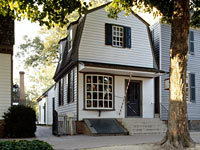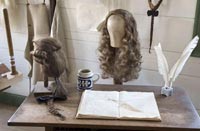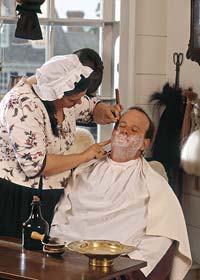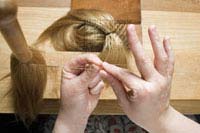Page content
Wigmaker
- Made wigs and hairpieces for ladies and gentlemen
- Cut and dressed hair
- Sold soaps, perfumes, powders, tonics and lice cures
- Trained apprentices
- Offered immersion bathing facilities
Gentry and businessmen wore wigs
Williamsburg, the capitol of Virginia, was the center of commerce and government, and provided an excellent opportunity for wigmakers and barber-hairdressers to make their trade a lucrative business. Barber and wigmaker establishments were generally located within or near taverns. This provided a consistent location to serve the needs of the customers – a place where one could openly discuss politics, day-to-day activities, and transact business deals.
Wigs show status, wealth
Tradesmen, merchants, clergy, military, ship captains and landed gentry patronized the wigmaker. Those who could afford wigs represented 5 percent of the total population of Virginia. Wigs were not only fashionable, but served as a way to convey one’s status within the community.
Wigmaking interpreted today in King's Arms barber shop
Today's shop represents Edward Charlton, who practiced the trade for more than a half century and became one of the most important 18th-century wigmakers in Virginia. Many prominent men in Virginia, such as Thomas Jefferson, Patrick Henry and George Wythe frequented his shop. Skilled tradesmen and interpreters today demonstrate the technology of the trade, while focusing on the role of the wigmaker and barber in history, as well as the social aspects of the trade.




